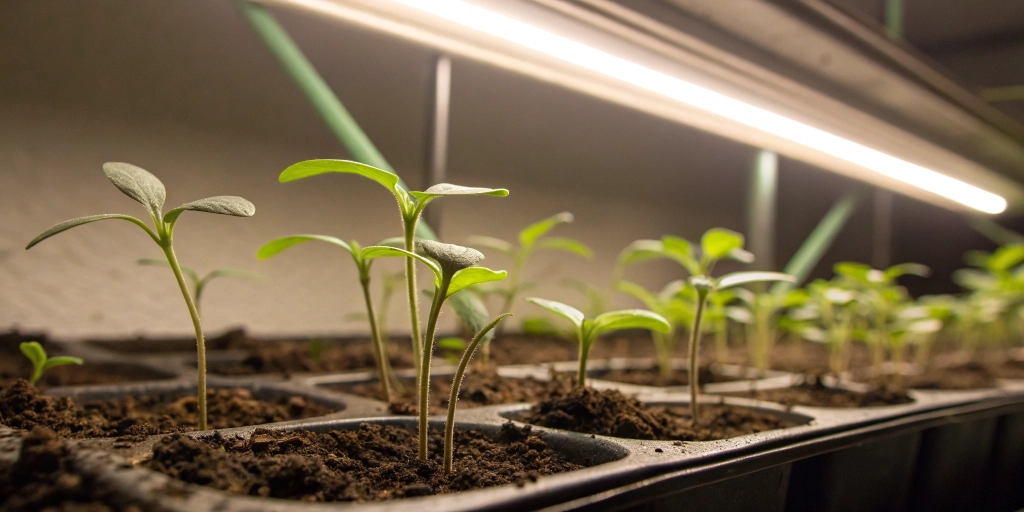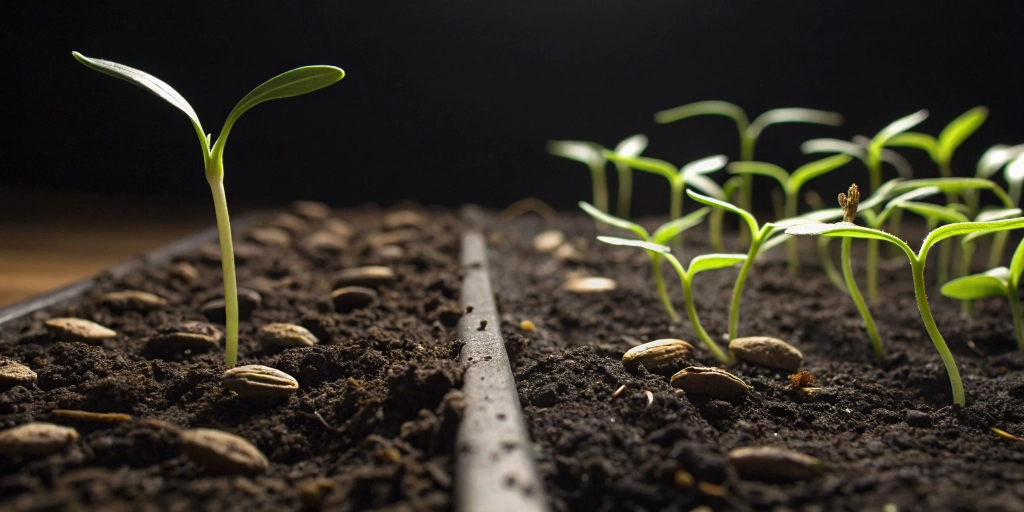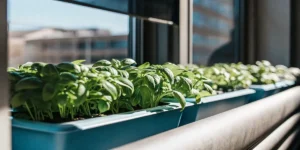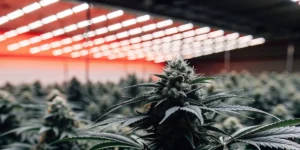Germination Basics
Impact of Moisture
Maintaining the right moisture balance sparks the germination process. Seeds need a damp environment to soften their outer shell. Overwatering can drown young sprouts, while too little moisture halts growth entirely. Aim for a medium that feels like a wrung-out sponge. Check it daily. Adjust watering to keep the surface slightly wet but not soaked. This fosters steady absorption and supports consistent emergence of the radicle.
Seed coatings vary by strain, so some demand more moisture than others. Keep containers covered with a clear lid or plastic wrap to trap humidity. Open covers briefly each morning to allow fresh air and prevent mold. Tiny droplets on the cover indicate high humidity. Remove excess water with a paper towel to avoid fungal issues. This simple routine preserves optimal conditions for early root expansion and seed health.
Temperature Importance
Seeds germinate best between 21 °C and 26 °C. Within that band, metabolic activity accelerates and the embryo swells. Temperatures outside this range slow development or cause dormancy. Place your setup on a heat mat or choose a warm corner of your grow space. Avoid surfaces that fluctuate in temperature, such as windowsills exposed to drafts.
Monitor daily with a small thermometer near your seed tray. If you spot cold spots, move the tray closer to a stable heat source. Too much heat spikes moisture loss and stresses seeds. Aim for gentle, consistent warmth. A small thermostat-controlled mat can simplify maintenance. This level of control maximizes germination rates and speeds up the process, so you get sprouts ready for planting sooner.
Light Myths
Many growers assume that light kick-starts germination. In truth, seeds use stored nutrients until they break through the shell. Photosynthesis doesn’t begin until green tissue emerges. That means you can germinate seeds in darkness without harming potential sprouts. A dark environment often protects delicate radicles from light shock and keeps temperature stable.
However, once roots emerge, seedlings crave a gentle glow. At that stage, brief exposure to indirect light encourages green pigment production. Avoid full sunlight at first; seedlings need soft, diffuse illumination. Keep them under a low-wattage bulb or near a bright window for a few hours daily. This staged approach delivers energy once sprouts display true leaves.
Scientific Evidence
Laboratory Studies
Researchers test germination under controlled moisture and heat, often using petri dishes or specialized trays. These settings isolate single variables to reveal clear patterns. Multiple trials confirm that darkness yields germination rates matching those in dim light. Scientists note nearly identical emergence speed, suggesting that light isn’t a triggering factor. Instead, humidity and temperature dominate results.
Some labs adjust light intensity post-root emergence. They document photosynthetic efficiency in seedlings under varied spectra. Blue-red mixes often produce sturdier leaves and stronger stems. That research helps hobbyists select bulbs for early stages. By separating germination from lighting, labs prove that young seeds depend on internal reserves until they unveil their first leaf.
Grower Trials
Experienced cultivators often run side-by-side tests in their grow rooms. They place one batch of seeds on a paper towel in a dark cabinet and another under a weak lamp. The outcome shows similar sprout counts and timing. Growers report no significant difference in taproot health or vigor between dark and dim-lit setups.
Field trials on larger scales also reflect this consistency. Professional nurseries germinate thousands of seeds in darkness trays, achieving above 90 percent success rates. They then move sprouts under LED racks. These real-world experiments reinforce lab findings. They highlight that light exposure during germination delivers no added benefit and can sometimes dry out the medium.
Comparative Results
When comparing methods, major factors emerge: moisture level, temperature stability, and seed vitality. Light presence shows negligible impact on germination percentages. In trials where all other conditions matched, darkness and low-light setups reached full germination within two to five days. Variations stemmed from seed age and storage, not from light differences.
Further comparisons reveal that once sprouts appear, consistent lighting improves leaf development. Growers moving seedlings from dark trays into a lighted chamber observe rapid greening. Those who delayed light exposure by more than three days often see slower chlorophyll production. Timing light application correctly maximizes early growth potential.

Practical Recommendations
Dark Paper Towel Method
Lay seeds between two damp paper towels and place them on a plate. Cover with a second plate or plastic wrap. This creates a mini greenhouse. Keep the towels moist by adding a few drops of water when edges start to dry. Check twice daily for root tips appearing from the shell. Once you see a taproot roughly 0.5 cm long, transfer the seed carefully to your final medium. Before starting, many growers ask, is it legal to buy cannabis seeds in their area—always check your local laws before purchasing or germinating seeds.
Avoid bright lights at this stage. Keep the plate in a cupboard or under a shelf to maintain darkness. Replace towels if they develop mold spots. Cleanliness prevents fungal attacks on delicate roots. By using this time-tested technique, you maximize your chances of a healthy, vigorous sprout ready for planting.
Soil Coverage Tips
Plant seeds about 0.5–1 cm under the surface of a light potting mix. Press the soil gently to eliminate air pockets around the seed. Don’t press too hard; compact soil can trap moisture and restrict radicle growth. Cover with no more than a thin dusting of soil. This layer keeps the seed in place and allows emerging roots to find the surface.
Keep soil moist but not soggy. Pump water gently at the base of the container to avoid washing seeds deeper. A spray bottle delivers even coverage. If you spot soil crusting, break it lightly with a small stick. That helps ensure shoots can break through once they develop cotyledons.
Light Exposure Timing
Once true leaves appear, aim for 18 hours of light daily. Use a timer on your grow light to establish a consistent schedule. Start with low intensity for the first day of light exposure, then increase power gradually. This gradual ramp-up prevents bleaching or stunting.
Select a bulb offering a blue-heavy spectrum in the 400–500 nm range. That range promotes leaf growth and shortens internodal length. Mount lights about 30 cm above seedlings to avoid heat stress. Adjust height as they grow. Uniform light distribution leads to even canopy development.
Special Cases
Auto-flower Seeds
Auto-flowering varieties fuse cannabis genetics with ruderalis lines to trigger flowering by age, not light cycle. However, germination remains the same. Treat auto-flower seeds like regular photoperiod ones: dark and moist until roots show. After sprouting, follow the strain’s recommended light schedule, often 18 hours on and 6 off throughout life.
Unique genetics may yield slightly faster emergence. Auto-flowering seeds sometimes germinate within 24–36 hours under ideal heat and moisture. Just watch your timing carefully. If you expose them to direct intense light too early, you risk bleaching. Gentle, staged illumination ensures robust vegetative growth before flowering triggers.
Fresh vs. Aged Seeds
Fresh seeds often germinate faster and with higher success rates. Their internal energy reserves remain strong. Aged seeds may require extra soak time in water for up to 48 hours to soften their outer shell. Change the water every 12 hours to prevent anaerobic conditions. Return seeds to the damp paper towel after soaking.
Even older seeds can germinate if stored correctly in a cool, dark place with low humidity. Expect some variability—germination rates may drop to 60 percent or lower. Test a small batch first when working with aged seeds. This lets you adjust environmental factors without wasting all your stock.
Soilless Media
Growing in coco coir, rockwool, or hydroponic setups demands precise moisture control. Seeds in rockwool cubes require pre-soaking in pH-adjusted solution (5.5–6.0) for 12 hours. Place them shallowly in a small cavity. Cover loosely with a dome to hold humidity.
In coco coir, mix with perlite to improve drainage. Keep the medium just damp, not waterlogged. Overwatering leads to hypoxic conditions and root rot. Monitor cubes or plugs for root tips before moving to deeper hydroponic channels. Once roots appear, increase oxygenation in your nutrient solution.
Monitoring Success
Radicle Emergence
The first sign of germination appears as a white taproot breaking the shell. Check under a magnifying glass if you struggle to see tiny tips. At that point, handle the seed by its shell, not by the root. Insert it gently into your chosen medium with the tip pointing downward to encourage straight root growth.
Keep the environment stable during this transfer. Sudden temperature changes or light shocks can stress sprouts. Carry trays swiftly from dark to light zones. If radicles dry out, briefly mist them before planting. Healthy roots should look moist and plump, not shriveled or slimy.
Early Leaf Development
Once cotyledons unfold, the seedling switches to photosynthesis. Expect true leaves with serrated edges to appear next. Use a soft light source for about 12 hours on the first day to ease photosynthetic enzyme activation. Increase to your standard schedule over three days.
Watch for leaf color. Pale green points to low nutrient uptake or weak light. Adjust nutrient solution strength or add more blue wavelengths. Strong, dark green leaves signal healthy chlorophyll production. Balanced growth here sets the stage for vigorous vegetative development.
Adjusting After Sprout
Continue monitoring moisture and temperature closely. Young plants thrive when conditions stay within optimal ranges. Shift from humidity domes to open air gradually over four days. This prevents the “dome shock” that can stunt growth. Raise humidity by 5 percent each day until ambient levels support the plant.
If you notice slow growth, inspect roots by lifting a seedling gently. Root-bound or waterlogged conditions hinder development. Repot in fresh medium if needed. Maintain your light schedule and nutrient mix, adjusting pH to 5.8–6.2. These small tweaks keep your seedlings on track.

FAQs about does cannabis seed need light to germinate
Should I cover seeds completely?
No, you only need a thin layer of soil or medium over the seed—about 0.5 cm deep. Too much coverage forces the seed to use extra energy reaching the surface. Lightly pressing down helps soil-seed contact and maintains moisture around the shell.
When is first light needed?
Expose seedlings to gentle illumination once cotyledons open. That usually happens two to five days after you begin germination. Start with four to six hours of low-intensity light and increase daily until you reach a full schedule.
Does excess light harm sprouts?
Yes, bright or direct light can bleach young leaves and stress tender stems. Keep bulbs at a safe distance and use dimmer settings at first. Gradually raise intensity over several days to build strength without overheating seedlings.





